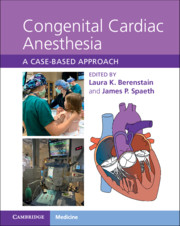Book contents
- Congenital Cardiac Anesthesia
- Congenital Cardiac Anesthesia
- Copyright page
- Dedication
- Contents
- Contributors
- Introduction
- Chapter 1 A Congenital Heart Disease Primer
- Section 1 Left-to-Right Shunts
- Section 2 Right-Sided Obstructive Lesions
- Section 3 Left-Sided Obstructive Lesions
- Section 4 Complex Mixing Lesions
- Chapter 21 d-Transposition of the Great Arteries (Arterial Switch)
- Chapter 22 d-Transposition of the Great Arteries (Atrial Switch)
- Chapter 23 l-Transposition of the Great Arteries (“Corrected” Transposition)
- Chapter 24 Total Anomalous Pulmonary Venous Return and Heterotaxy Syndrome
- Chapter 25 Truncus Arteriosus
- Section 5 Single-Ventricle Physiology
- Section 6 Heart Failure, Mechanical Circulatory Support, and Transplantation
- Section 7 Miscellaneous Lesions and Syndromes
- Index
- References
Chapter 24 - Total Anomalous Pulmonary Venous Return and Heterotaxy Syndrome
from Section 4 - Complex Mixing Lesions
Published online by Cambridge University Press: 09 September 2021
- Congenital Cardiac Anesthesia
- Congenital Cardiac Anesthesia
- Copyright page
- Dedication
- Contents
- Contributors
- Introduction
- Chapter 1 A Congenital Heart Disease Primer
- Section 1 Left-to-Right Shunts
- Section 2 Right-Sided Obstructive Lesions
- Section 3 Left-Sided Obstructive Lesions
- Section 4 Complex Mixing Lesions
- Chapter 21 d-Transposition of the Great Arteries (Arterial Switch)
- Chapter 22 d-Transposition of the Great Arteries (Atrial Switch)
- Chapter 23 l-Transposition of the Great Arteries (“Corrected” Transposition)
- Chapter 24 Total Anomalous Pulmonary Venous Return and Heterotaxy Syndrome
- Chapter 25 Truncus Arteriosus
- Section 5 Single-Ventricle Physiology
- Section 6 Heart Failure, Mechanical Circulatory Support, and Transplantation
- Section 7 Miscellaneous Lesions and Syndromes
- Index
- References
Summary
Total anomalous pulmonary venous return is a rare disorder characterized by the lack of direct connection of the pulmonary veins to the left atrium; instead, the pulmonary veins connect either directly to the right atrium or indirectly via a vein connected to the right atrium. This results in oxygenated blood ultimately draining into the right atrium and mixing with deoxygenated blood, necessitating a right-to-left atrial shunt to survive. Although it can be an isolated defect, in approximately two-thirds of cases total anomalous pulmonary venous return is associated with complex cardiac defects and frequently with heterotaxy syndrome, an embryologic disruption of right and left laterality of the thoracic and abdominal organs. Children with heterotaxy and total anomalous pulmonary venous return have even higher rates of early and late morbidity and mortality. This chapter details the perioperative management of a patient with recurrent pulmonary venous stenosis and intestinal malrotation requiring urgent abdominal surgery and outlines the appropriate management strategies for high-risk patients with this physiology.
Keywords
- Type
- Chapter
- Information
- Congenital Cardiac AnesthesiaA Case-based Approach, pp. 169 - 177Publisher: Cambridge University PressPrint publication year: 2021

